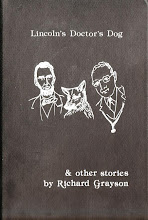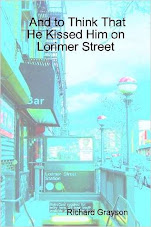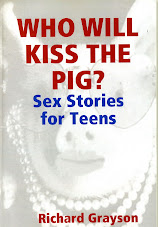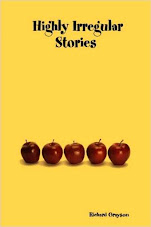
The December 1979-January 1980 issue of the
Washington Review of the Arts reviews Richard Grayson's
With Hitler in New York on page 34:
 WITH HITLER IN NEW YORK by Richard Grayson,
WITH HITLER IN NEW YORK by Richard Grayson,
Taplinger Publishing Company, 200 Park Avenue South,
New York, New York, 10003, $7.95 The title story of this collection of stories by Richard Grayson begins:
"Hitler's girlfriend and I are waiting for him in the International Arrivals Building at Kennedy Airport. Ellen and I stand in front of the West Customs Area. My brother is standing in front of the East Customs Area. He is waiting for my parents. My parents and Hitler have each landed at the same time, at seven o'clock. My parents are flying KLM from Saint Maarten. Hitler is flying Laker from London and Manchester . . ."
Hitler arrives in a leather jacket. He suffers from jet lag. He has breakfast at McDonald's – he likes fast food. Hitler and friends have dinner at Shakespeare's in the Village and Hitler hopes for another New York blackout. Later Hitler dunks his girlfriend in the swimming pool:
"'You're a sadist, you know that?' Ellen says to Hitler after they get out of the pool. Hitler shrugs. 'He did the same thing to me in Greece last year,' she says." This is the closest Grayson comes to characterizing the familiar Hitler. Otherwise Hitler drinks Becki's beer and makes jokes and tried to cheer the narrator up when his grandfather dies. The story ends, "Hitler put his hand on my shoulder and tells me to sleep well."
This story, "With Hitler in New York," is wry and funny and wonderfully imaginative. And Grayson avoids what might be expected – either intrusive fantasy or broad comedy. The tone instead is cool and neutral. Watching Grayson pull off this story is like watching a flying Wallenda. It is dazzling and dangerous.
"'What do you think of Hitler?' Ellen asks me as I take her to her parents' house. We are driving along the Belt Parkway at midnight with our car windows wide open, but there is not a hint of a breeze.
'I kind of like him,' I say. 'I never realized he was so witty.'
Ellen kisses me on the cheek at her parents' house. I watch to see that she gets in safely." In its bland, neutral control, the story is chilling not only because of the subject but the irony of the setting. The setting is nice, everyday family. The friends seem genuinely friends. The narrator is touchingly grieved at his grandfather's death and sympathetic in his concern and observation of Hitler. The tone and realistic style of the story creates a jolting closeness. "With Hitler in New York" implies that the fantasy of the supermarket tabloid is close to true, closer than the news that's fit to print.
Richard Grayson is thirtyish, but he has published over a hundred and thirty stories, two of them "Understanding Human Sexual Inadequacy" and "Super Fab Senators," in the Washington Review. The dissimilarity of these two stories is not atypical. Grayson uses more diverse forms than any story writer I know. At the same time he maintains a distinctive quality that blends. Unlike many collections of short stories, which to read at once is like eating a quart of ice cream in one sitting, these stories are varied and spicy enough to urge you on. In fact, the numbers and versatility of Grayson's stories give the impression that stories must light on him like flies. If God is in the details, as someone said, it is also true that stories are in details, and Grayson seems not only good at detail but sees than even at varying levels when accumulated, they can make a story. Take "Peninsular People":
"The Weitzes, who live on the peninsula, are a five-surfboard family. They are aspiring or failed actors; they are psychology majors turned dancers; they are mountain climbers and real estate saleswomen and managers of Burger Kings. The Weitzes live above their means. All of them smoke marijuana, and are liberated, and are Unitarians, and are bored . . .
"There is Mrs. Vincente, who didn't listen to people and refused to put her mother in a home, and her son Louis, who keeps taking the law boards in hopes of scoring better and who is marking time in the meantime. They like living on the peninsula."
Grayson often uses "names" of our time, underlining, like Warhol, our perpetual consciousness of "names" and employing them, as Warhol did, as an emotional reflection of our culture. Presented here are stories on Justice Burger and Pol Pot. Appearing are Farrah Fawcett-Majors, Fulton J. Sheen, John Ashbery, and others. Grayson uses them best in a casual off-handed way as he does in "In the Lehman Collection." Or "Real People," a story based on the national game of "guess-who-I-saw-today":
"Betty Friedan is walking across City Hall Park. She is not wearing a bra . . ." When the names themselves dominate the story as in "Chief Justice Burger, Teen Idol," the device is too obvious. The same is true, I think, in "Lincoln on the Couch," an historical flashback. The author seems forced to balance the obviousness of the device with an equal degree of outrageousness and irreverence. But even so, Grayson uses the incongruity of the language to create fresh and funny scenes:
"
Yuck, thinks Mary Todd, looking across the breakfast table at her husband's face . . ." In a different form of story, "Go Not to Lethe," a TV soap opera is celebrating its twenty-seventh anniversary with its twenty-seven year star Grayson Richards and his co-starring Jewish family. "Au Milieu Interieur," which first appeared in the anthology Statements 2 published by the Fiction Collective, is composed as a series of questions. It begins, "What is a dream?" The development of the story is the characterization of the narrator, which is both complex and fascinating. "Au Milieu Interieur" is an example of how fine an experimental or innovative form can be when handled by a writer who understands the organic development of a story.
Throughout all these stories Grayson's style is supermarket informational with intrusive irrelevancies. Though Grayson refuses to limit himself, especially in the Jewish family stories he will resort to a traditional setting and atmosphere. But commonly the irrelevant details is presented with as much weight as the supposedly "important" facts, making a scene as non-selective as experience itself (which is of course ironic since Grayson as the artist is ultimately controlling and selective). Some of the most successful stories are the scenes of the Jewish family. "Slowly, Slowly in the Wind" begins:
"Here we go again. Grandpa and Grandma have taken the newspaper coupons and the shopping cart and gone out to Pantry Pride. I am in the apartment watching Great-Grandma Chaikah. She is watching Dinah Shore.
'You know she's Jewish?' Great-Grandma Chaikah says. 'Southern but Jewish.'
I nod. The bell rings. It is Mrs. Brody, our neighbor."
There is also more to enjoy in this book than stories. The introduction by the author is so nice you want to run to the phone and urge Richard Grayson to begin his autobiography immediately. Even "A Note on the Type" is a lark:
"Few people have noticed the similarities between the fiction of James M. Cain and the poetry of Wallace Stevens. Of course, the common denominator is that both are set in Electra . . ." And "Exquisite pornography," it tells us, "is often set in Granjon."
I must admit that there are one or two stories in With Hitler in New York that I could have done without. "Ordinary Man," a sort of science fiction story, is one. And I wish Grayson would rewrite "The First Annual James V. Forrestal Memorial Lecture" because it begins marvelously and then disintegrates, which the story itself admits. I say that, knowing that probably fourteen new stories are buzzing around Grayson this instant. But I say it because Angela Cozzarelli, who is practicing to be the great intellectual figure of the 1990s and the nice Jewish boy who went to the Newman Club picnic to watch his heartthrob Eddie Dugan play softball without a shirt, deserve better. They are individual and real and wonderfully conceived. The fact is that even in a story one might quarrel with, Grayson is still so good there is always a lot to like and admire.
This is a terrific book. Read it. Give it to your friends.
– PATRICIA GRIFFITH



















































































